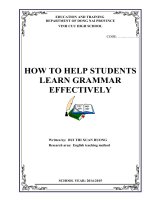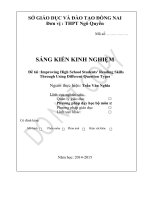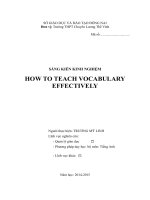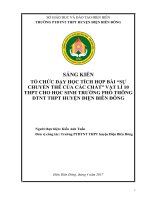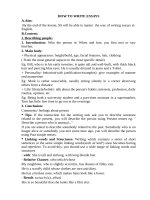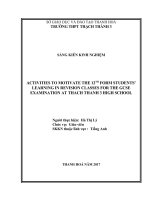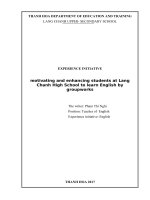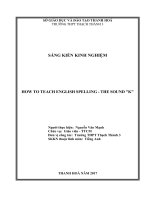SÁNG KIẾN KINH NGHIỆM HOW TO HELP STUDENTS LEARN GRAMMAR EFFECTIVELY
Bạn đang xem bản rút gọn của tài liệu. Xem và tải ngay bản đầy đủ của tài liệu tại đây (1.38 MB, 39 trang )
EN
G
L
IS
H
DẠY
TỐT
HỌC
TỐT
EDUCATION AND TRAINING
DEPARTMENT OF DONG NAI PROVINCE
VINH CUU HIGH SCHOOL
CODE: ………………
HOW TO HELP STUDENTS
LEARN GRAMMAR
EFFECTIVELY
Written by: BUI THI XUAN HUONG
Trang 1
Research area: English teaching method
SCHOOL YEAR: 2014-2015
Trang 2
CURRICULUM VITAE
I. PERSONAL INFORMATION
1. Full name: Bui Thi Xuan Huong
2. Date of birth: April 7
th
1986
3. Male/female: female
4. Address: Tan Trieu village, Vinh Cuu district, Dong Nai province
5. Phone number: 0918.539253
6. Email:
7. Career: English Teacher
8. Work at: Vinh Cuu High School
II. EDUCATION
1. University: B.A in English
Year graduated: 2010
Trained specialty: English
2. Post graduated: MBA
Year graduated: 2013
III. EXPERIENCE
Experienced professional field: Teaching
Year of teaching: 6
Trang 3
TABLE OF CONTENTS
Trang 4
HOW TO HELP STUDENTS LEARN GRAMMAR EFFECTIVELY
I. REASONS FOR CHOOSING THE TOPIC
Nowadays, English has been considered as one of the most popular
languages. It is now the key factor of globalization- of political views, international
business as well as education (Johnson, 2009). Thanks to the development of
economic with oversea investment and tourism more and more people spend time
and money taking English classes at schools or private centers with the hope that
they can better their communication in English so that they are able to study
abroad, and look for good jobs with high income. Realizing how important English
is in education, the Ministry of Education and Training in Vietnam has a number
of policies to develop both teachers and students’ English proficiency. For
instance, the project of improving teachers’ English proficiency following The
Common European Framework of Reference (CEFR) standard by the end of the
year 2020 has been carried out recently to provide further training for those who
are not qualified enough. Furthermore, students in Dong Nai province have
opportunities to study with foreign teachers, especially Filipino teachers.
Despite the fact that teaching English has some improvement recently in the
light of learner-centered approach which is adaptable to help students better their
English, teaching and learning English in Vietnam has not developed students
grammatical competence, motivation, and activeness. The students are expected to
be proficient at English after graduating from high school, although there is a
considerable studying time, many Vietnamese students are still not able to use
English grammar correctly and confidently.
As a matter of fact, grammar is very helpful for students. Pradeep (2013)
states that grammar is a very important part that cannot be neglected in teaching
and studying English. It can be taught through different methods either explicit or
implicit. However, Denham (1992) highlights the fact that teachers instruct most of
their lessons through Grammar Translation Method approach (GTM) which is
known as teacher-centered and makes students bored. This suggests that it’s high
time for teachers to teach grammar in a variety of ways to allow students to better
their grammar competence as well as enhance four main skills including reading,
listening, speaking and writing. Thus, in my opinion, it is necessary to carry out
this study to make practical benefits for students by applying workable methods.
II. THEORETICAL PERSPECTIVES AND REALITY
1. Theoretical perspectives
The role of grammar in teaching and learning English
According to Harmer’s viewpoint (1987, pp.12) “Without some
understanding of Grammar, students would not be able to do anything more than
utter separate items of language for separate functions. The expression of
Trang 5
functional language is only possible through the use of the Grammar of the
language”
Firstly, teaching grammar helps students understand how the language
works. Apart from vocabulary, students need to know grammar to understand how
it is written or how words are combined together to understand the proper
meaning. Without grammar or with a poor knowledge of grammar, they may get
confused with complicated expressions. Appropriate grammar techniques are
embedded in meaningful, communicative contexts then contribute positively to
communicative goals and they also promote accuracy within fluent communicative
language use.
Secondly, Smith (2001: 15) claimed that if teachers neither pay attention to
grammar nor create opportunities for learners to improve grammar, learners are
likely to stand the risk of fossilization or reach a point where they can cope with
level of communication that is demanded of them by making use of their existing
grammatical resources and communication strategies and probably with sufficient
fluency. Surely, they do not see the need to develop their linguistic abilities any
further.
In favor of the importance of grammar, Larsen – Freeman (1986:13) affirms
that grammar is regarded as a skill rather than an area of knowledge. Learners do
not simply store knowledge about the language and its usage; they need also to
develop an ability to do something. They must have a chance of learning situations
to overcome the knowledge problem. It is true to say that grammar is the fifth skill
besides four skills reading, writing, speaking, and listening. Skill development as
well as learning grammar takes practice. Grammar might not be taught only when
the students already possessed the knowledge and the ability to use the grammar
item in speech, writing and listening comprehension. In fact, grammar is the basis
for mastering four language skills. When we have concrete foundation of grammar,
we feel much easier to advance.
In general, grammar is acknowledged to be of importance in language study
and in language teaching and learning in particular. Grammar is acquired naturally
from meaningful input and opportunities to interact in the classroom. More
especially, learners can improve their grammar competence in a suitable
environment without conscious focus on language forms. However, this partly
depends on the learning circumstances. As a result, grammar teaching gains its
significant role in English Language Teaching because highly developed language
skills are difficult to achieve without some knowledge of grammar. Teacher should
help students to acquire grammar knowledge through meaningful contexts which
improve students’ motivation.
The important of students’ motivation
Since motivation is not only a vital but also a highly complex factor
determining more or less successful language learning, it is necessary to examine
approaches to motivate in learning in order to bring about better insights into it.
Trang 6
Over the years there have been in numberable studies on motivation in foreign and
second language learning. In these studies, researchers have attempted to explain
what is meant by motivation.
However, most studies on motivation in foreign and second language
learning have been influenced by the work of Gardner (1985) (quoted in Spolsky,
1998), who defines motivation as consisting of effort, plus desire to achieve the
goal of learning, plus favorable attitude towards learning the language
Another theory on motivation can be seen from Littlewood’s perspective
(1998:53) that “in second language learning as in every other field of human
learning, motivation is the crucial force which determines whether a learner
embarks on a task at all, how much energy he devotes to it, and how long he
perseveres. It is a complex phenomenon and includes many components: the
individual’s drive, need for achievement and success, curiosity, desire for
stimulation and new experience, and so on”.
Apparently, Littlewood, not only highlighting the important role of
motivation in second language learning but also emphasizing the ‘highly complex
construct’ of motivation claimed that if a learner is motivated she will probably
decide to undertake a particular task with certain amount of energy and time
needed for it.
Furthermore, McKay and Tom (1992:2) point out that the need and drive to
communicate with others in a new language provide strong motivation for most
learners.
This is more or less similar to Lightbown and Spada’s (1999: 56) definition of
motivation in second language learning that “motivation in second language
learning is a complex phenomenon which can be defined in terms of two factors:
learner’s communicative needs and their attitudes towards the second community”
They also add that '' if learners need to speak the second language in a wide
range of social situations or to fulfill professional ambitions, they will perceive the
communicative value of the second language and will therefore be motivated to
acquire proficiency in it. Likewise, if learners have favorable attitudes towards the
speakers of the language, they will desire more contact with them.”
Learners’ motivation can change overtime and effect on their language
learning. Various studies have found that motivation is strongly related to success
in language learning.
Gardner (1985) (quoted in Spolsky, 1998) sums up “… it seems clear that
achievement in a second language learning is influenced by
attitudinal/motivational characteristics. Postulating that achievement in a second
language learning is promoted by an integrative motive is not tantamount to saying
that this is the only cause or predictor”.
However, many research findings shows that successful learning can
enhance motivation, and the relationship between learning achievement and
Trang 7
motivation is an interactive one. As Gardner and Smythe (1981) (quoted in Hedge,
2000) claim that the high correlation between motivation and successful learning
confirms the crucial importance of motivation in the classroom whether learners
arrive with it or whether they acquire it through classroom experience.
2. Reality
Most of the students in my school are not good at English as well as they
don’t enjoy learning English grammar. Most students consider that grammar
structures in their textbooks are boring with too much grammar rules and tiring
exercises. My students often have the same comments about the challenges and
difficulties of English grammar such as “There are so many rules”, “It is so
difficult to remember the patterns”, “I made mistakes when I did grammar
exercises although I learnt carefully”, “I don’t know how use all the English tenses
correctly” and so on. What can we do to solve these problems? As a Vietnamese
high school English teacher, I realize that it is time to change the ways we teach
English grammar.
One of the most common ways of teaching English grammar in my school is
to instruct students by Grammar Translation Method (GTM) which focuses on
forms. First of all, teachers provide students the form of the new grammar point
and givin examples so that students can understand. After that teachers explain the
usage ot the grammar point if necessary and ask students to apply the new
grammar structure to complete exercises. At the end of the lesson, they ask the
students to learn the grammar point by heart and finish all the exercises in
workbook at home.
The way of teaching grammar mentioned above are very common in most
public as well as private school in Vietnam. In my point of view, it clearly shows
some problems. Firstly, students feel bored and frustrated with the tiring rules and
execises . They have no interest in learning English grammar and they learn the
grammar rules just because they are forced to do so. As a result, students lose their
motivation. Secondly, students don’t know how to use the new grammar structures.
Trying to remember the forms and rules is not enough. More importantly, students
should know how to apply the grammar points appropriately and correctly in
whatever cases. Finally, students lack of revision. It's easy to forget previous
grammar points if they just learn by heart. So, teachers should provide students
exciting repetition activities.
Many works have been carried out to find out the effective ways to improve
students’ grammar acquisition as well as other basic skills. From my own
experience and many reference books, I have used some solutions to deal with the
arising question
Trang 8
“How can teachers help students to learn grammar effectively?
I wish these solutions can allow me and other English teachers to
successfully resolve the problems in teaching grammar features and help the
students better their grammar acquisition.
III. SOLUTIONS
I have applied the following solutions at Vinh Cuu high School in classes
10A1, 10A2, 11A1 and 11A2 from the beginning of the school year 2014-2015.
3. Teaching grammar in a non-stressed and exciting environment
1.1. What to teach
Teachers frequently need to present new grammar to learners and grammar
presentations are often at the heart of language lessons. However, English
grammar is very complex, so teachers often want to strengthen or supplement the
grammatical explanations in order to meet the particular learning events in their
own classrooms. As a matter of fact teachers can use variety ways to instruct
grammar lessons and they can use not only the course book with ‘ready-made’
presentation but also other materials like a reading texts or online activities.
Normally, teachers convey lessons about the following points:
1) the new structure and its possible forms
2) the meanings imparted by the structures in context
3) the core of what the student needs to learn
Therefore, teachers should find the ways to present the structure and to
check that whether the students are interested in the grammar lessons or not and
the core concepts are understood within a certain context.
1.2. How to teach
3.1.1. Using games
The understanding of a lesson is more easily achieved when students are
engaged, interested and having fun during the lesson. In fact, many games have
been conducted in order to teach grammar effectively in an exciting and relaxing
learning environment.
1.2.1.1 Word puzzles
It is a useful and interactive method whereby students can learn all sorts of
important parts of English grammar. They can be used to encourage students to
identify and understand various parts of a sentence; grammatical concepts like
synonyms, tenses and conjugations; or incorrectly used grammar. Word puzzles
such as crosswords are easily modified to suit all age and skill levels and
Trang 9
introduce an element of fun competition into the learning process, so they can be
invaluable in forging a full and lasting understanding of English grammar.
1.2.1.2 Bingo
The game of Bingo is based on people marking off spaces on their card
until they fill in a row or column fully. In normal Bingo these are numbers,
drawn at random from a pool. In grammar lesson Bingo, they could be pronouns,
verbs, nouns, sentence structure, antonyms, and so on – students could use the
daily newspaper and attempt to find correct examples of these grammatical
concepts faster than each other, thereby “winning” the game – and learning in the
process! Short and fun grammar exercises like this can be included on a regular
basis during your lessons to keep correct grammar usage fresh your students’
minds and improve their recall of the topics at hand.
1.2.1.3 Jumbled Sentences
Choose a number of sentences from the last few chapters (pages) that you
have been working on in class. Make sure to choose a nice mixture including
adverbs of frequency, time signifiers, adjectives and adverbs, as well as multiple
clauses for more advanced classes. Type (or write on the board) jumbled versions
of the sentences and ask the students to reassemble them. If you are focusing on
specific grammar points, have the students explain why certain words are placed in
certain places in a sentence. For example, If you are working on adverbs of
frequency, ask students why 'often' is placed as it is in the following negative
sentence: 'He doesn't often go to the cinema.'
1.2.1.4 Whisper Circles
With the aim to teach the grammar structure (it takes to do ) I used a game
named whisper circles
+ Divide the students into groups of 7 to 10.
+ Choose one leader from each group. Give the leaders the card which has
the sentence "It takes about six seconds for something you drink to reach
your stomach." Ask him to memorize the sentence, go back to his group
and whisper what he has read on the card to the person on his right. Each
person will whisper the sentence to the next person and the sentence can
be said only once. The last person will say the sentence out loud. If the
sentence is the same with the one written on the card, that group wins.
1.2.1.5 Match and catch the riddle
When instructing simple present tense, I can take advantage of this activity to help
my student involve more in the lessons.
Trang 10
+ Divide the class into two groups: The QUESTION group and the
ANSWER group.
+ Give the questions to the first group and the answers to the other group.
Each student in the first group is supposed to read the question he has
aloud and whoever has the answer in the other group reads the answer
aloud.
If the question and the answer match, put the students in pairs. If they
don’t, continue till the right answer is found. Each student can read his
part only twice. When all questions and answers are matched ask the pairs
to read the riddle they have just for fun.
1.2.1.6 Crazy story
To present simple past tense or reported speech I will ask my student make
their own story
+ Prepare sheets of paper with six columns which bear the following titles
at the top
WHO? (a man's name)
WHOM? (a woman's name)
WHERE?
WHAT DID HE SAY?
WHAT DID SHE SAY?
WHAT DID THEY DO?
+ Divide the class into groups of 6. Give each group one sheet of paper.
Ask the first student to write under the first part and fold the paper so as to
cover what he has written. Tell the student to pass the paper onto the next
person. As each person writes, he should only look at his fold. When all
students finish, one student from each group will be asked to read their
story in the following format. You can write the format on the blackboard.
met in/at
He said
She said
And so they
1.2.1.7 Find the differences
It is helpful for teachers when teaching the following structures there
is/are , s/he has , s/he is ing, s/he is + adjective)
Trang 11
+ Find or draw two pictures which are the same except for seven features.
Photocopy them on separate sheets of paper.
+ Ask students to work in pairs. Give one copy of each picture to the pairs.
The pairs are not supposed to show their copies to each other. Partner A
will describe their copy and Partner B will listen carefully and examine
their own copy to find the differences. They can ask questions if they
require more detailed information or need any clarification. The pair that
finishes first wins the game.
3.1.2. Eliciting
Instead of simply giving the grammatical structures, teachers ought to
engage students more by drawing those patterns from the students. We should
invite student to give their ideas as well as make suggestions. Students are also
encouraged to contribute what they know already and make guesses at the new
structures. This is called eliciting.
Eliciting helps focus students’ attention and help students brainstorm the
ideas. This involves the class even if students do not know the grammar point
being elicited. Furthermore, students are encouraged to contribute what they
already know or partly know. So this technique is useful for teaching mixed ability
classes. In addition, teachers can see what students know and what they do not
know by eliciting. Therefore, we can adapt the presentation to the level of the
class. Of course, it takes teachers more time to elicit new structures. However, it
will catch students’ attention and they will remember the lesson more. The more a
student engages with a new grammar point, the more likely he is to learn it.
Teachers can elicit new grammar points using the following ways:
1.2.1.8 Eliciting from visual aids
There are probably as many reasons for using visual aids as there are
instructional aims but in my opinion there are two main reasons a teacher should
consider using pictures, flashcards, realia, and so forth. First visual aids increase
the effectiveness of any lesson because they clarify meaning instantly. Second,
using visual aids increase motivation and stimulate students’ interest. However, in
any situation teachers are still the most effective visual aids.
For instructing tenses and time words, I can use time lines so that my
students can realize the forms of the tenses easily such as past simpe, past
progressive and past perfect in Unit 3 English 10 page 32 (Figure 1)
Trang 12
Figure 1
Many grammar points can be illustrated by boxes or circles labeled
appropriately such as relative clause in Unit 15 English 10 page 156 (Figure 2).
1.2.1.9 Eliciting from guessing
Students can guess the rules which they have never actually been taught
because language often follows rules. Moreover, eliciting is one way of
Trang 13
encouraging students to guess and to work out rules for themselves. Learning
through this way will fill students with enthusiasm.
EX: To elicit how to add –ing after Verbs, I write on the board:
love à living
drive à ?
In addition, a teacher can also have students guess a new structure based on
their background knowledge.
EX: To elicit the usages of simple present tense, I will write down a
sentence on the board “ The Earth goes around the Sun”. Students know that this is
a truth, a fact. So that they can draw out one of the usages of this tense is to talk
about the truth.
3.1.3. Showing the forms
Teachers are recommended to show the forms of a new structure in case
students don’t know it. In fact, we can write a formation on the board. It is a
traditional method using PPP Technique (Present- Practice- Produce). However,
some students get bored when they are taught by this way and some are easy to
forget the given structure as they are forced to learn by heart. To make them
remember longer, it is necessary to link the structure with a certain context for
further practicing. In fact, we can all grammar point through this way. The mot
important thing is helping students become engaged more into the lessons
EX: in order to instruct the grammar point reported speech in unit 5 English
11, I will some examples for my student to draw out he forms.
• Direct speech: “I like ice cream”.
• Reported speech: She says she likes ice cream.
3.1.4. Give students practice in using the grammatical patterns
This step often takes place after we have presented the structure of the
lesson. We can do this by asking student to role play using the new structure,
asking students to fill in the blanks, asking multiple-choice questions, asking
students to make sentences with the new structures and so on.
1.2.1.10 Asking students to role play
After presenting a new structure, teachers can ask students to role play using
the grammar point to be sure that students really understand the forms and usage of
the structure in context. Role play is a very useful way to practice what students
have learnt. It can help students better their communicational skills, interpersonal
skills, conflict resolution, as well as improve group decision making, and develop
insights.
Trang 14
For example, after presenting how to make suggestions using the following
structure
Why don’t we + V……?
What / How about + V-ing……… ?
Let’s + V…………
After that, we can divide class in to small groups (three students for each group).
Then one student of each group will choose a piece of paper which providing a
situation for students to role play randomly. After 10 minutes each group will
come up and perform. Which group has the best performance will be the winner.
EX: You and your friend are going to have a picnic this weekend but
you don’t know where to go. One of your friends want to visit Tran Bien Temple.
But other members don’t like this idea. Another one suggest to go to Suoi Tien
Park. But it’s too far. So you suggest to go to Bien Hung Park that is in the center
of Bien Hoa City. Let’s make your own conversation using the given information.
1.2.1.11 Asking students to fill in the blanks
After teaching a certain grammar point, I ask my students to do the following task.
Fill in the blanks with the correct forms of the verbs:
1. She (go)________to Nha Trang two weeks ago.
2. What _____you (do)______ yesterday?
3. My father (not/ watch) ________TV last night.
4. When I (be)____ a little girl, my father (take)______ me to the park.
5. _____you (eat)______breakfast this morning?
We can make the above task become more interesting by designing it as a
game. For example, the teacher shows the questions in turn. The class is divided
into two groups. The students raise their hands to get the right to answer. Each
correct answer will be awarded one point. The winner will be the group with more
points at the end.
1.2.1.12 Asking multiple-choice questions
I ask students to do the following task.
Choose the best answer A, B, C, or D:
1. I need _______ some new clothes.
A. buys B. buy C. to buy D. buying
2. I can_________very well.
A. sing B. singing C. sings D. to sing
Trang 15
3. My sister often ____________ school by bike
A. go to B. gos to C. goes to D. goinging to
4. I sometimes _________ yoga at home with my mom.
A. do B. play C. go D. make
5. They _______________ from Bien Hoa city.
A. come B. comes C. are coming D. have come
This kind of exercise is very common in examination but it is so boring.
Therefore, teachers can make it more interesting by designing it as a competition
game in which the questions are shown in turn.
1.2.1.13 Asking students to make sentences with the new structures
This task will be easier and more interesting if students work in groups and
compete with each other. This activity will encourage the student to use the
structures in real communication. Therefore they can enhance their speaking
ability.
When I finish the first semester (the school year 2014-
2015), I conveyed a survey on my students towards the following question.
Did my ways of teaching grammar make you feel like learning English
grammar and memorize them longer?
Class Total Not at all A little A lot
quanti
ty
% quanti
ty
% quanti
ty
%
10A1 45 2 4.4
%
6 13.3
%
37 82.2
%
10A2 44 0 0% 8 18.2
%
36 81.8
%
11A1 46 1 2.2
%
10 21.7
%
35 76.1
%
11A2 45 2 4.4
%
12 26.7
%
42 68.9
%
Based on the result of the survey, we are able to recognize that most of the
students (more than two thirds) found that my ways of teaching grammar made
them more active and really enjoyed learning English grammar points so that they
can memorize them for a long time. At a matter of fact, this will enhance students’
Trang 16
motivation in learning English grammar in specific and other aspects of English in
general. When I apply the traditional Grammar Translation methods in teaching
grammar, my students also get good results in written tests which focus on
checking grammatical competence. However, they cannot using the grammar
points they’ve learnt before in their speaking. In comparison with the new
methods I realize that my students not only get better results in the exam but also
they can improve their speaking skill.
All of my lessons are conducted using communicative activities with the
purpose to improve students’ communicative ability. Hence, I also made a survey
in which I can identify how often the students communicate with their classmates
through the activities in class by examining the following question.
Did you have more opportunities to interact with your classmates by
when I applied communicative activities?
Class Total Not at all A little A lot
quanti
ty
% quanti
ty
% quanti
ty
%
10A1 45 5 11.1
%
10 22.2
%
30 66.7
%
10A2 44 4 9.1% 14 31.8
%
26 59.1
%
11A1 46 6 13.4
%
10 21.6
%
30 65.2
%
11A2 45 2 4.4% 15 33.3
%
28 62.2
%
From the above survey, we can see that more than 50% of the students have the
chances to communicate with their friends via the activities which teachers used in
class. As I observed my class, I found that most of the students are very active
from the beginning until the ends. They raise hands to answer and other students
clap hands to encourage. From what I see they can create meaningful sentences
using new grammar point. In addition, classroom environment is lively and funny.
It seems that 8 to 10 minutes is not enough for playing the games. When time is
up, some students even do not want to stop. I see that my students cooperate well
and communicate with others frequently in order to contribute ideas, discuss the
answers, and make possible sentences. Hence, students’ speaking time is increased
nearly 60%.
Trang 17
4. Helping students to consolidate the grammar patterns regularly
If students don’t have a lot of chances to review the grammar points they
have learnt, it is easy for them to forget. Revision is really important and
necessary. Thus, teachers need to help students consolidate the structures as often
as possible. In fact, there are a lot of activities to help students review what they’ve
learnt. In this part, I’ll suggest some reviewing activities that are designed as
games so that students have more interest in studying. Teachers can organize these
activities whenever necessary.
1.3. Using games
4.1.1. Shoot for Points
We often need to review things that are not fun, things like the past
simple or pmjast participle of irregular verbs. Instead of the classic Q & A
activity, we can use a large container or trash can as your “basket”, give your
students a ball and have them shoot for points. But here’s the catch: you’ll ask
them a question in past simple, and they’ll have to remember the past correctly in
order to earn the chance to shoot. They can get 10 points for scoring or five if they
miss (because at least they answered the question correctly). You can try any
variety of this type of game, whether you use large balls or small ones, or even a
wadded up piece of paper.
4.1.2. Board Game
Everyone loves a board game, and students will particularly appreciate one
if it’s not only loads of fun, but also a helpful way to review essential
grammar. You can design your own to include the tenses and structures your
students have learned.
4.1.3. Tic Tac Toe
Tic Tac Toe is another versatile game, one that can be adapted to suit a
wide variety of needs. What you need to decide first is which grammar your
students need to review for the test. Then, write the topics on nine index cards or
large enough pieces of paper. Arrange the cards face down on a table or stick them
on the board, in the classic Tic Tac Toe 3 x 3 grid.
Next, teams take turns choosing a square (you can add letters across and
numbers down to make it easier to call out the squares). You turn over the card
and reveal to your students the tense/structure/grammar point written on it.
Students must then either provide an example or ask a question that another team
member must answer correctly to get their X or O on that square. Of course, the
first team that gets three Xs or Os across, down or diagonally wins.
Trang 18
4.1.4. Snakes and Ladders
To play this classic game in your grammar review lesson, you’ll first need
to prepare some cards: they may have verb tenses written on them, questions your
students must answer or prompts from which to say a complete sentence.
The rules are simple, but the game is so much fun! Students must first
choose a token to move around the board (a different colored button for each will
do nicely!) Then they take turns rolling the dice to move across the board. They
must take a card and answer correctly to remain on that spot, or move back two
places if they are incorrect. If they land at the bottom of a ladder, and they answer
correctly, they get to move up the ladder, but if they land on a snake’s head they
automatically move down to where its tail is.
4.1.5. Football
First, you’ll need to draw a playing field like this one on the board or a
large piece of paper:
Next, divide your students into two teams. Place a “ball” token at the center.
Then, students must answer questions correctly to approach the posts and score a
goal. For example, Team A answers correctly and moves right one step closer to
their goal. Team B answers correctly and moves the ball left back to the center.
Team A answers incorrectly and can’t move the ball at all. Team B answers
correctly and moves left one step closer to their goal. If Team A were to keep
answering incorrectly and Team B correctly, then Team B will continue moving
left to eventually score a goal. When a team scores, the ball moves back to the
center, and the team that did not score last starts. The team with the most goal
wins
1.4. Jumbled sentences
To help students review the new structure, I divide the class into small
groups and ask students to re-order the given words to make meaningful sentences
Ex: Her/ often/ reads/ in/ she/ free/ book/time
She often reads book in her free time.
Trang 19
I show a set of jumbled sentences in turn. The students raise their hands to
get the right to answer. Each correct answer will be awarded a point. The winner
will be the group with the most points at the end.
1.5. Matching
This activity is very popular to review what students have learnt. Teachers
can design it as a competitive game so that students can review the lesson by
playing game. Teachers divide class into groups. Each group will take turn to
match two halves of sentences. Which group has more correct answers will be the
winner.
EX: When reviewing conditional sentences Type 2, we can use this activity.
1.6. Chinese whisper game
One more activity teacher can use to review the grammar structure is
Chinese whisper game. This is a game-like activity which plays in groups and it
requires all members of each group take part in the game. First, after teaching a
grammar point, teachers can create two groups. Each group will sit in line. The
first players of two groups will see a sentence given by the teachers. Then he/she
will come back and tell the next player and continue to the end. The player sit at
the back will go to the board and write down the answer. Which group has more
answers will win the game.
Trang 20
1.7. Find someone who
This is also an activity which can not only review grammar pattern but also
enhance students’ speaking and listening ability. First of all, teacher will prepare a
handout which some questions such as Find someone who has two brothers? So
students can review yes/no questions of present perfect tense. “Have you ever….?
Yes, I have…./ No I have never…. Students are required to work individually to
complete the task in the handout. Who finish first will be the winner.
1.8. Picture description
Students are divided into groups of four. Each group receives a picture and
they have five minutes to discuss and then describe the given picture using the
grammar pattern they have studied before. For example, look at the picture about
the living room and use the structure there is/ are to describe it.
At the end of the first semester (the school year 2014-
2015), I made a survey on my students towards the following question.
Trang 21
Did my revision activities help you consolidate the grammar better?
Class Total Not at all A little A lot
quantit
y
% quantit
y
% quantit
y
%
10A1 45 0 0% 5 11.1
%
40 88.9
%
10A2 44 1 2.3% 8 18.2
%
35 79.5
%
11A1 46 0 0% 11 23.9
%
35 76.1
%
11A2 45 2 4.4% 13 28.9
%
30 66.7
%
From the table above, we can clearly see that more than two thirds of the
students found that my revision activities helped them a lot in consolidating the
grammar. My students really enjoyed participating in my revision activities. This
created an active and lively atmosphere in class and it enhanced retention and
recall. Many students said that they preferred my revision activities to the exercises
that they had to do individually on the worksheets.
1.9. Sentence chains
This activity is used to review all structure that students have learnt before.
Basically you are allowed to add one sentence to the story at a time (no double
posts!) and we watch as a really bizarre story unfolds. You can carry out it as a
game playing by two teams so that it can be more interesting. Which team has are
able to add more sentences will be the winner.
EX: There were an old man standing in front of my house
G1: He was wearing black suit and hold a stick on his hand
G2: I haven’t seen him before.
G1:……………….
5. Guiding students how to learn grammar effectively
Teachers often force students to memorize all the grammatical rules,
patterns, tenses without teaching them how to improve their grammar knowledge
on their own or giving them some strategies to better their learning. Therefore,
many students have the tendency to do as many exercises as they can to learn by
heart the rules or structures. According to some recent study, it is easy for the
Trang 22
student to forget what they have learnt. Thus this way of learning language which
is known as rote memorization is considered as an ineffective way. As a matter of
fact, many students depend too much on rote memorization in their learning so that
they can pass the exams. After a long time, students are used to learning grammar
lesson by lesson through sheer repetition. Although they can remember words,
they will forget them easily soon. In addition, students will feel that it is boring to
learn grammar, and gradually lose their interest in grammar lessons. It takes too
much time. That’s why there are a lot of students who are bored with learning
grammar.
Hence, it’s necessary to guide students how to learn grammar effectively. I
often give my students the following guidelines.
1.10. Raise your motivation
One of the most important factors that enhances grammar learning is
motivation. You will find it very hard to study grammar day after day without
motivation. It is believe that being profiecent in English grammar will better your
English learning at school and ensure your future job. Motivation can help you to
have a more exciting and fulfilling life. If you want to learn English grammar
effectively, you need to figure out what motivates you. Do you want to learn
grammar to pass the exam? Do you want to learn English grammar to get high
marks and see the smiling faces of your parents or someone who is special to you?
Do you want to learn English well to have the admiration of your friends? Do you
want to improve your current learning, attend university, or enjoy your life in an
English speaking country? Do you want to learn English words to communicate
with foreigners or get a good job in the future? You yourself need to understand
your motivation
1.11. Be aware of grammar
You should notice the aspects of grammar that are the same as or very
similar to those in your language. In addition, you should pay attention to the way
that English expresses an idea differently to how it is done in your language. For
example, English and Vietnamese have different words order. If you notice
grammar similarities and difference you will probably learn the rules more quickly.
Besides, concentrate on the aspect of grammar you personally find most
difficult. (if you don’t have any idea, ask your teacher for help). It is necessary for
you to focus on these aspect with special care and attention when edting your
writing. In speaking, it is more difficult, however you can take sometimes can try
to get these aspect right. For example, when you are telling a story in simple
present tense, you should bear in mind that you need an –s in the third person
singular.
Trang 23
1.12. Learn grammar with association and fun
You can improve your grammar knowledge by using the following techniques:
* Association: Association is the mental glue that helps you ‘stick’ the
information in your brain. In terms of learning, it means linking ‘what you want to
learn’ with ‘something you have already learnt’. When you receive new
information, it helps to hook this information to existing information in your brain.
The more you learn, the more hooks you will be able to make in your brain. With
more ‘hooks’, you will be able to ‘hang’ more information on your brain. Connect
new information with something you already know. Use the Internet or talk to your
friends to find out examples, stories, events, or illustrations that are associated with
what you are learning. This will help you have new associations in your brain.
* Fun: Try to search for ways and means with the help of which you can have
fun while memorising. Generally, it is difficult to do so. Most students associate
learning and memorising with stress. If you do this, you will continue to have more
stress while memorising. Think different. Try to have fun. The best way to
improve your grammar knowledge is to have fun when learning. If you are having
fun, it actually makes it easier for you to learn things, so make sure that you make
learning grammar fun.
1.13. Study regularly
Learning English grammar is not just something you do every now and then.
You should do it every single day. When you study each day, it is easier to retain
the new things that you learn. Also, you will see that you can review the structures
faster every day and you will definitely remember what you learn better as well.
However, you do not need to sit down for hours. If you want to learn
English grammar well, learn step by step is better. Study for fifteen minutes every
day instead of two hours once a week. If you commit to just 15 minutes a day of
focused grammar practice, you will soon have firm grammar knowledge.
Moreover, you should not try to learn too many structures, patterns or rules in a
single time. When you learn only one every day, you will find that it is easier.
Keep track of your progress and you will amaze yourself on how much you will
better your knowledge.
1.14. Read a lot of English books
This may sound strange but in fact all the time you are reading English (and
also listening to English), you are taking in models of correct grammar that will
help you in your own writing and speaking. It will help you when you express your
ideas and when you come to check your work. Of course, it is even better if you
can read with the grammatical awareness.
Trang 24
1.15. Make sure to practice
There is a saying “Practice makes perfect” so practicing is probably one of
the most important tips if you want to learn grammar effectively. Your memory is
like a muscle. The more you exercise it, the stronger it becomes. The more you
practice, the fewer mistakes you will make. As a result, you can use English
grammar effectively.
1.16. Learn with your friends
Learning with your friends is fun. You can fix a particular day of the week
(such as Saturday or Sunday) to review your grammar or play some grammar
games with your friends. You can ask your friends to test your grammar. You can
also practice the exercises together. When you study English grammar together,
you can help each other to understand many things that have puzzled you.
1.17. Use the Internet
There are some online computer programs which can help you learn about
how words are used and how grammar works. Those are helpful to most students
because they can draw out the rules by themselves so that they can remember
longer. The programs are free and available. Therefore, you can use them
whenever you like to learn, review, and practise.
At the end of the first semester (the school year 2014-
2015), I made a survey on my students towards the usefulness of my
instructions to the students in learning grammar.
Class Total Not useful Useful Very Useful
quantit
y
% quantit
y
% quantit
y
%
10A1 45 0 0% 7 15.6
%
38 84.4
%
10A2 44 1 2.3% 10 22.7
%
33 75%
11A1 46 1 2.2% 15 32.6
%
30 65.2
%
11A2 45 3 6.7% 14 31.1
%
28 62.2
%
Trang 25
